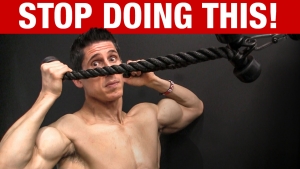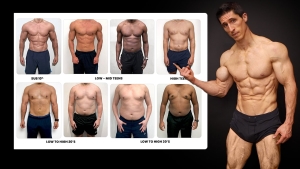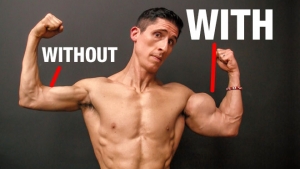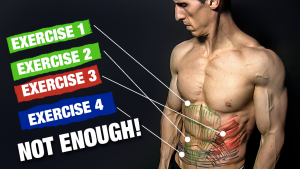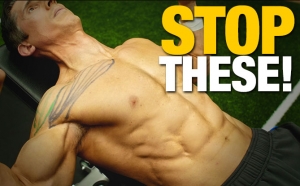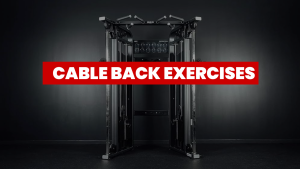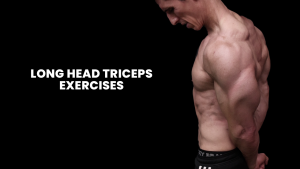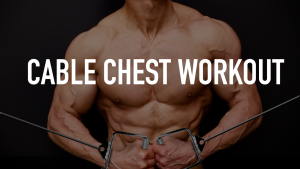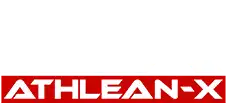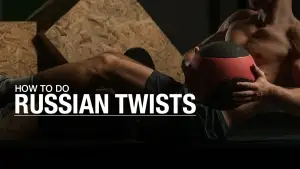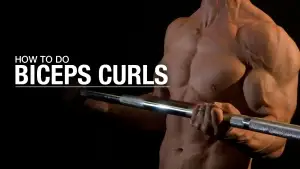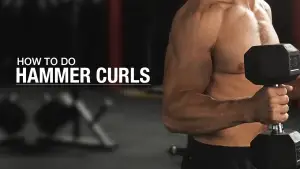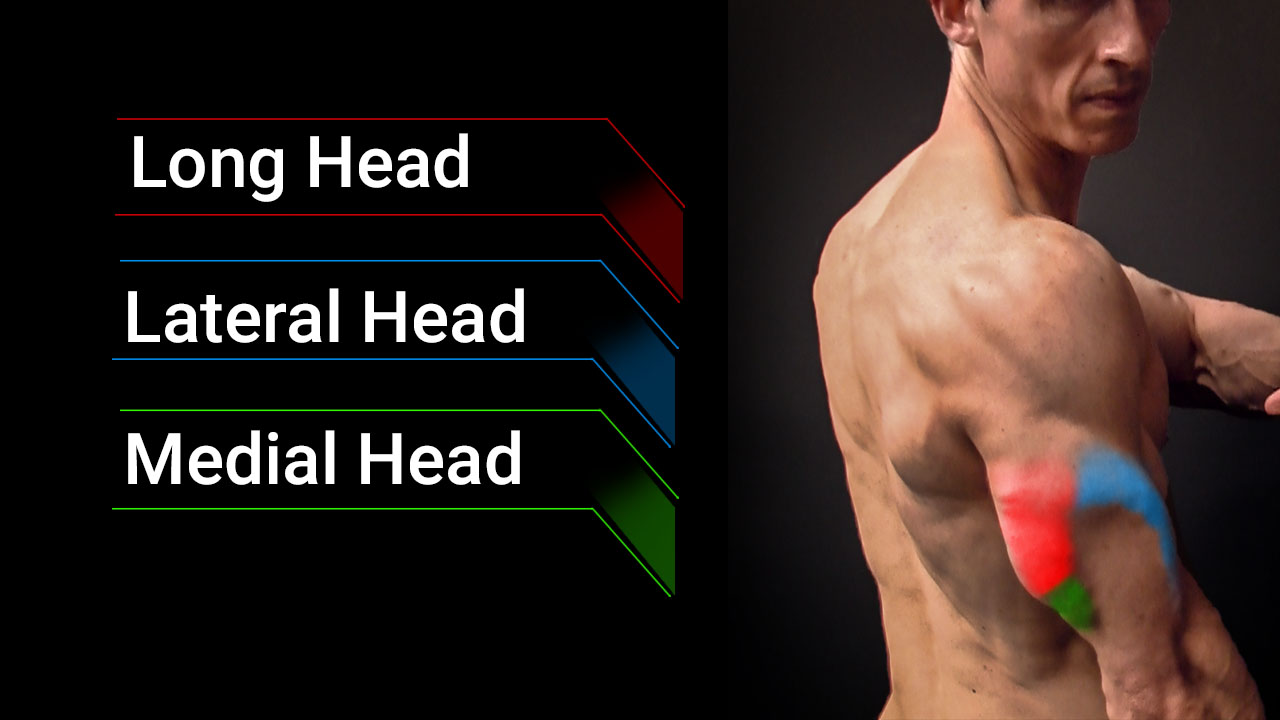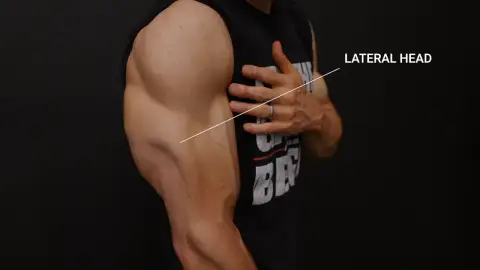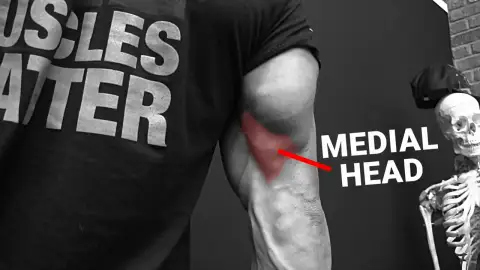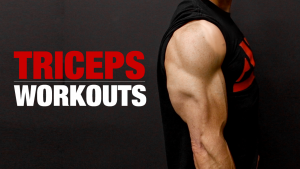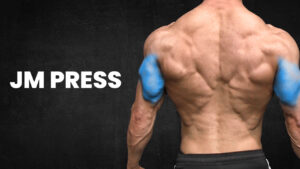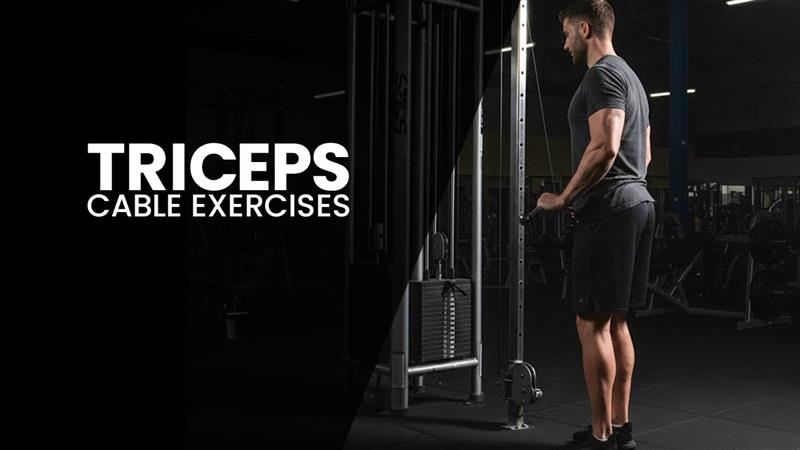
WHY use cables for building triceps?
I’m talking about your triceps brachii.
This muscle is the real engine behind your Bench Press, Overhead Press, and nearly every upper body push you do.
Yet most lifters treat it like an afterthought, cranking out half-reps on the Cable Pushdown and wondering why their arms never grow.
If you’re not training all three heads of the triceps (the long head, lateral head, and medial head) with the right cable machine exercises, you’re never going to move up a shirt size.
Cable machines keep constant tension through every inch of elbow extension, making it one of the smartest tools for real muscle activation, balanced development, and joint-friendly strength training.
Today, I’m breaking down the best tricep cable exercises, how to target each head for maximum muscle growth, and how to fix the mistakes that are holding your arms back.
TRICEP CABLE EXERCISES: MUSCLES WORKED
Before you start ripping through Triceps Pushdowns on the cable machine, it’s important to understand which muscle groups you’re working.
The triceps brachii isn’t one solid slab of muscle. It’s three distinct triceps heads that each play a role in elbow extension, upper-body strength, and total arm size.
The secret to real muscle growth isn’t more sets. It’s understanding how to train the three heads of the triceps muscle through different angles and ranges of motion.
And that’s exactly where cable machine exercises shine. It provides constant tension, complete activation, and zero wasted reps.
Here’s a closer look at the target muscles for tricep cable workouts:
LONG HEAD
The long head of the tricep sits on the inner portion of the upper arm, running from the scapula down to the elbow.
It’s the only one of the triceps heads that crosses both the shoulder and elbow joints, which means it assists in shoulder extension as well as elbow extension.
Because of this dual role, the long head is best trained when the arm is positioned overhead. For example, I’d recommend exercises like Overhead Triceps Extensions and 1-Arm Overhead Cable Triceps Extension.
These cable machine exercises place the muscle under stretch, improving muscle activation and stimulating muscle fibers that are often neglected during basic Tricep Pushdowns.
Training the long head of triceps helps build full, rounded arm thickness and provides critical support in compound pressing movements like the Barbell Bench Press and Overhead Press.
LATERAL HEAD
The lateral head of the tricep forms the outer portion of the upper arm. It’s the muscle that gives your arm that visible “horseshoe” shape.
Its primary function is elbow extension, but it’s most active when pushing against heavier loads and through a shorter range of motion.
Exercises like the Cable Tricep Pushdown, Rope Extension, and Straight Bar Tricep Extension using a high pulley are ideal for targeting the lateral heads.
These movements allow you to maintain constant tension using the cable stack system, something free weights or resistance bands can’t replicate due to changing resistance curves.
Using different handle grips such as neutral grip with a rope or underhand grip with a bar shifts emphasis slightly between muscle fibers while reducing stress on the elbow joints.
Strengthening the lateral head of triceps improves arm definition while it also enhances your ability to lock out heavy presses and contributes to total upper-body strength.
MEDIAL HEAD
The medial head of the triceps lies underneath the other two heads and runs deep along the humerus.
Though it’s less visible, it plays a crucial role in stabilizing the elbow and supporting smooth, controlled elbow extension during both compound and isolation exercises.
You’ll engage the medial head in nearly every tricep movement, but it becomes particularly active during lighter or more controlled lifts like Cable Reverse-Grip Pushdowns, 1-Arm Triceps Cable Press Downs, or Cable Triceps Kickbacks from a low pulley.
Because this head contributes heavily to endurance and control, high repetition sets or slow, paused reps can enhance its muscle activation and joint support.
A strong medial head of the triceps helps maintain healthy elbow joints, improves form, and reduces the risk of exercise-related injuries during heavy resistance training.
It’s a stabilizer that supports everything from Dumbbell Chest Presses to Bent-Over Rows, keeping your arms steady under load.
BEST TRICEP CABLE EXERCISES
Not all cable triceps exercises are created equal. Some build size, some build stability, and some just waste your time.
The difference comes down to exercise technique, training form, and knowing which movement best targets each head of the triceps.
The cable machine gives you one major advantage over free weights and bodyweight moves: constant tension through the full range of motion.
Whether it’s an Overhead Tricep Extension, Cable Rope Tricep Extension, or 1-Arm Cable Triceps Kick Back, the goal is the same: isolate the triceps, maintain core stability, and drive progressive overload without wrecking your spine alignment or elbow joints.
When performed correctly, these lifts don’t just add inches to your arms.
They enhance functional strength, reduce injuries, and even support your long-term fitness journey by improving joint mechanics and recovery.
CABLE TRICEPS PUSHDOWNS


HOW TO DO THE CABLE TRICEPS PUSHDOWN:
- Stand facing the cable pulley machine with your feet shoulder-width apart and a short straight bar attached to the high pulley.
- Grip the bar just outside shoulder width and keep your chest tall with a tight core.
- From here, pull the bar down toward your thighs, driving the movement by extending only at the elbows.
- Keep your upper arms locked to your sides. That means no swinging and no shoulder assist.
WHAT MAKES IT EFFECTIVE: The Triceps Pushdown isolates the triceps through a complete range of elbow extension, maximizing muscle activation in the medial head of the triceps while also engaging the lateral head for balanced development. Unlike free-weight movements, the Cable Triceps Press Down provides constant resistance through every inch of the rep, which helps build strength and size without unnecessary muscle damage or joint stress.
SINGLE-ARM CABLE TRICEPS PUSHDOWN


HOW TO DO THE CABLE TRICEPS PUSHDOWN:
- Set the cable pulley just above head height and attach a rope or single handle.
- Take a staggered stance for balance and grab one side of the rope with an offset grip. You’ll be pulling to one side at a time.
- Keep your elbow locked close to your body and your chest tall.
- Drive your hand down and slightly back until your arm is fully extended, squeezing the triceps hard at the bottom.
- Pause for a second, then return to the starting position under control.
WHAT MAKES IT EFFECTIVE: The Single-Arm Triceps Pushdown isolates each arm and allows a greater extension behind the body, which increases the contraction through the long head of the triceps. That extra range of motion gives you a stronger squeeze, better mind–muscle connection, and improved balance between sides.
ROCKING TRICEPS PUSHDOWN

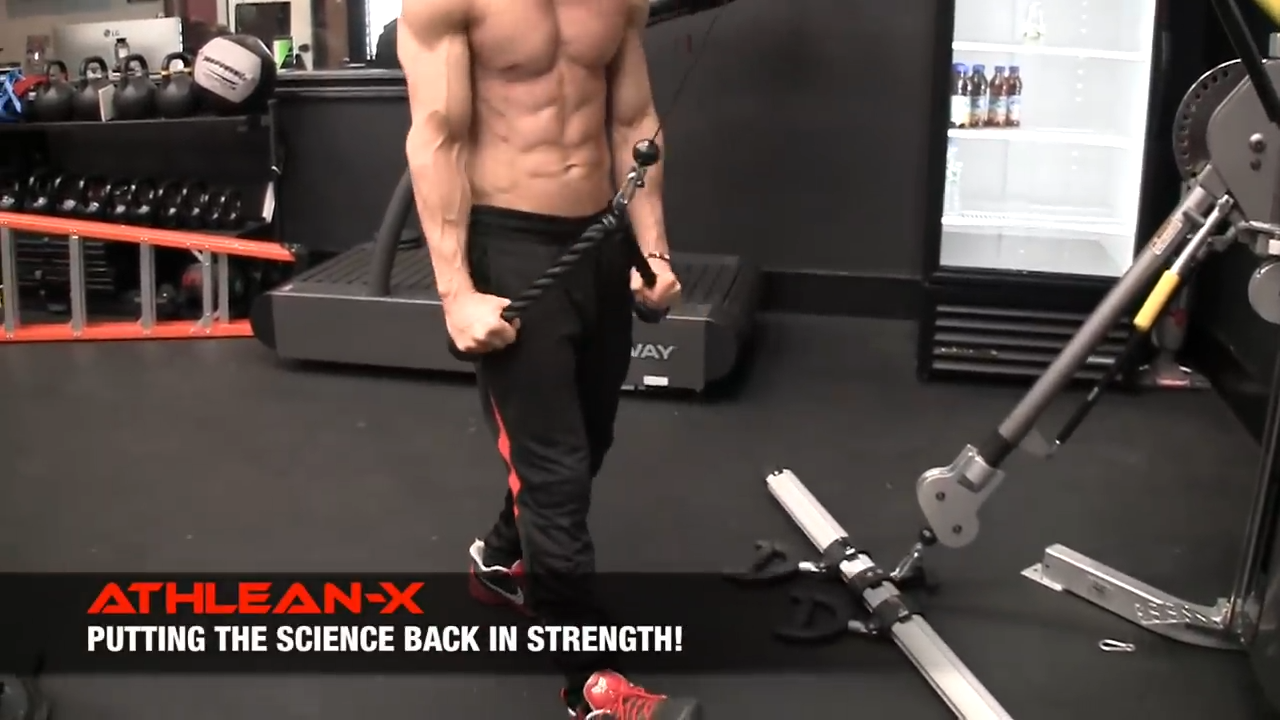
HOW TO DO THE ROCKING TRICEPS PUSHDOWN:
- Set up in front of the cable station with a rope attachment, taking a staggered stance for balance.
- Start with your weight slightly forward on your front foot and elbows tucked tight to your sides.
- As you press the rope down, shift your weight backward onto your rear foot, keeping your core braced and chest tall.
- The key is to move with the cable, not against it, so the resistance line stays aligned with your arms through the entire motion.
- Return to the starting position under control and repeat, staying smooth and deliberate with each rep.
WHAT MAKES IT EFFECTIVE: The Rocking Triceps Pushdown changes the resistance curve mid-rep, creating peak tension at every point in the range of motion. By rocking back as you press down, you shift the cable’s angle just enough to keep the triceps under constant load. That means no dead zones or wasted effort.
DRAG PUSHDOWN

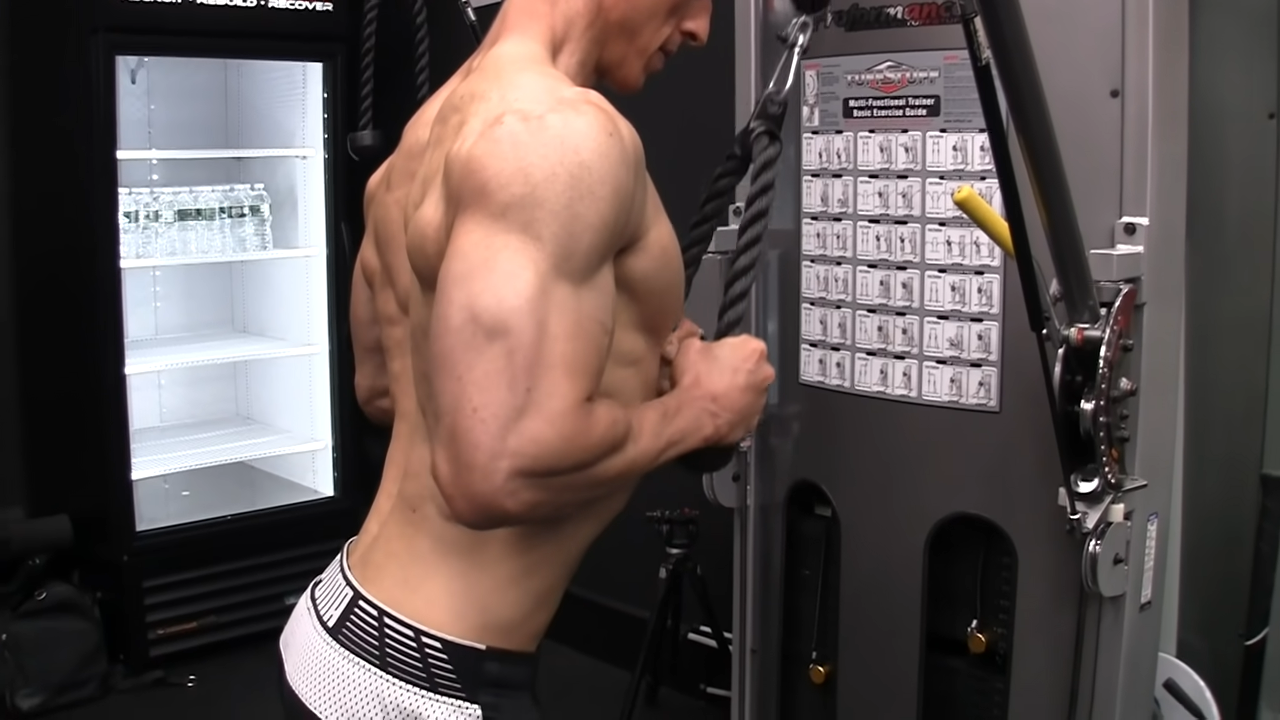
HOW TO DO THE DRAG PUSHDOWN:
- Stand facing the cable machine, gripping a rope attachment with both hands.
- Keep your feet shoulder-width apart and hinge slightly forward at the hips while maintaining an upright chest and tight core stability.
- Now here’s the key difference from a standard cable triceps pushdown: instead of letting your elbows drift forward, pull them back behind your torso.
- As you push the rope down, drag it close to your body, keeping the elbows pinned and your shoulders slightly retracted.
- Extend fully through the elbows until lockout and pause to squeeze the long head of the triceps at the bottom.
- Focus on smooth technique rather than load. This isn’t about moving the stack. It’s about controlling the cable tension and maintaining perfect spine alignment throughout the movement.
WHAT MAKES IT EFFECTIVE: The Drag Pushdown changes the resistance angle to fully shorten the long head and that’s something most lifters miss with Standard Rope Extensions or Flat Bar Pushdowns. By keeping the elbows behind the body, you maximize mechanical advantage and maintain full muscle activation through the final phase of elbow extension.
CABLE TRICEPS PUSHAWAY


HOW TO DO THE CABLE TRICEPS PUSHAWAY:
- Set up facing away from the cable station with a rope attachment secured to a high pulley.
- Take a staggered stance for balance and bring your upper arms near your ears, elbows bent, hands gripping the rope. Your torso should be angled slightly forward, maintaining a tight core and neutral spine.
- From this overhead extension position, push the handles forward and slightly downward until your elbows are fully extended.
- Control the return, letting the arms drift slightly back behind your head to feel a deep stretch in the long head of the triceps before driving the next rep.
WHAT MAKES IT EFFECTIVE: The Cable Triceps Pushaway works the long head through a fully stretched position, which is something Standard Cable Triceps Press Downs or Rope Triceps Extensions can’t replicate. Allowing the arms to travel slightly higher behind the head enhances that stretch and recruits more muscle fibers in the long head, improving both muscle activation and overall functional strength.
UNDERHAND TRICEPS PUSHDOWN

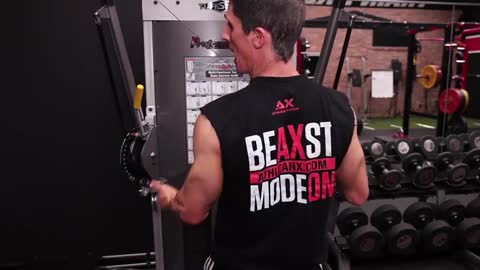
HOW TO DO THE UNDERHAND TRICEPS PUSHDOWN:
- Set up facing the cable machine with two high pulleys crossed in front of you, each fitted with a single-handle attachment.
- Grab the left handle with your right hand and the right handle with your left hand using an underhand (supinated) grip.
- Step back from the stack so the cables cross just above your chest.
- With your elbows tucked tight to your sides and your chest tall, press the handles down and slightly back toward your hips.
- Focus on driving the motion from the elbows (not the shoulders) and fully extend until you feel your triceps contract hard at the bottom.
- Return slowly to the starting position, resisting the pull of the cables the entire way.
WHAT MAKES IT EFFECTIVE: The Underhand Crossover Pushdown shifts tension toward the long head and medial head of triceps while keeping the shoulders out of the movement. The crossed-cable setup changes the line of pull, forcing the triceps to stay engaged through the entire elbow extension. There’s no drop-off in resistance at the bottom. By pulling the handles down and back, you’re extending the triceps through a longer range of motion, creating stronger muscle activation and better lockout strength.
CABLE OVERHEAD EXTENSIONS

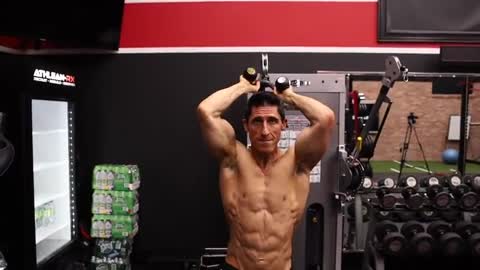
HOW TO DO THE CABLE OVERHEAD EXTENSION:
- Set the pulley at the top of the cable station and attach a rope handle.
- Grab the rope with both hands, palms facing in, and step forward into a staggered stance for balance.
- Keep your upper arms close to your head and your chest tall. From here, extend your arms forward and slightly up until your elbows are fully straightened.
- Control the return by allowing your hands to come back behind your head, feeling that deep stretch in the triceps before driving the next rep.
- Stay upright and don’t hinge forward or let your elbows flare. Keep your core tight, your posture strong, and make the triceps do the work.
WHAT MAKES IT EFFECTIVE: Overhead Cable Triceps Extensions hit the long head of the triceps in its most stretched position. Standing tall and lifting your arms high through each rep increases tension where it matters most and helps bring the muscle to full fatigue by the end of each set.
COMMON TRICEP TRAINING MISTAKES
Even the best cable triceps exercises can fail if your execution or intent is off. It’s not the movement that builds your arms. It’s the mechanics behind it.
Every rep should serve a purpose, challenge the right muscle fibers, and protect your joints in the process.
Here’s where most lifters go wrong, what happens when they do, and how you can avoid these same mistakes.
TURNING IT INTO A SHOULDER OR CHEST EXERCISE
The triceps extend the elbow. That’s their job. But once the elbows start drifting forward, the shoulders and chest take over, shifting tension away from the triceps completely.
This is one of the most common problems in Cable Triceps Press Downs and pulldown machine variations.
When your upper arm moves instead of staying fixed, the triceps lose their mechanical advantage and the long head never fully contracts.
Over time, this habit not only limits muscle activation, but also adds unnecessary strain to the shoulder joint.
The solution isn’t more weight. It’s precision.
Keep your elbows locked near your sides during Triceps Pushdowns and slightly overhead during Triceps Extensions.
In Cable Single-Arm Extensions or Single Arm High Cable Tricep Extensions, think about moving only from the elbow joint while keeping the rest of the body quiet.
That’s how you build targeted strength without letting other muscles do the work for you.
USING TOO MUCH WEIGHT
Loading the stack doesn’t mean loading the muscle. When the weight’s too heavy, momentum replaces tension and the triceps stop doing the job.
You’ll see this everywhere: lifters leaning back, jerking the cable down, or using their lats to start the rep.
Once that happens, the exercise shifts from isolation to chaos. The triceps miss their peak contraction, and the arms never move through a full, controlled range.
Using excessive load also accelerates fatigue in supporting structures, especially the shoulders and wrists, increasing the risk of muscle damage or overuse irritation down the road.
True strength athletes and elite weight and power lifters know that the goal isn’t moving weight, it’s creating tension.
Controlled, deliberate motion builds more force in the muscle, drives progressive overload, and protects the joints for long-term performance.
PARTIAL RANGE OF MOTION
If you’re stopping halfway up or halfway down, you’re training your ego, not your triceps.
A shortened range of motion means the long head never fully stretches and the medial head never gets to lock out, and these are the two most important parts of the movement for complete development.
Partial reps can be useful at the end of a set for burnout, but when they become your default pattern, they train weakness, not strength.
The last few degrees of elbow extension are where the triceps work hardest and skipping that means skipping growth.
Training through a full range also promotes better joint health and improves coordination for pressing movements like the bench and overhead press.
Think of it as strength through control, not just strength through load.
OVERTRAINING WITHOUT INTENTION
More work doesn’t always mean more results, especially for a muscle group that’s already assisting in every major press you do.
The triceps are heavily recruited in compound pressing movements, so adding endless isolation sets often leads to systemic fatigue without measurable improvement.
Chronic overuse not only limits muscle growth but can interfere with recovery, leading to nagging elbow or shoulder pain that stalls progress.
Smart training programs build triceps strength by combining heavy compound work with strategic isolation, not endless volume.
The goal should be integration, not exhaustion.
Quality over quantity keeps tension high, recovery steady, and performance climbing all while supporting long-term injury prevention initiatives and keeping you out of the musculoskeletal rehabilitation cycle.
IGNORING THE LONG HEAD
The long head of the triceps is often neglected because it requires a stretched position, which is something most lifters avoid.
Standard Cable Triceps Pushdowns don’t fully engage it, meaning two-thirds of your arm’s potential never gets trained effectively.
The long head responds best when the arm is overhead or behind the body, as in Overhead Cable Triceps Extensions, 1-Arm Overhead Extensions, and Kickbacks done with proper range.
Neglecting these movements not only limits size but also creates strength imbalances that affect your bench press lockout and overall pressing stability.
Training the long head through full range improves muscle balance, shoulder integrity, and overall functional strength.
PROGRAMMING AND PROGRESSION
How you fit your triceps work into your training matters just as much as how you perform it.
Cable exercises can either build serious pushing strength or just leave your arms tired and overworked.
It all depends on when you do them, how hard you push, and how you track your progress.
Here’s how to program and progress triceps cable workouts:
PLACEMENT IN YOUR WORKOUT
Think of your triceps cable work as precision training, not the main event. The heavy compound lifts, such as Bench Presses, Overhead Presses, and Chest Dips, should always come first.
Those movements hit the triceps in a multi-joint pattern and build real strength. Once that foundation is set, cables come in to isolate, refine, and reinforce.
On push or upper-body days, finish your workout with 2 to 3 targeted cable movements. You’ll already be warm and neurologically primed, so lighter weight and stricter form will hit the triceps harder.
If you train on a dedicated arm day, start with one big triceps compound (like a Close-Grip Bench or Weighted Dip), then transition into cables for controlled hypertrophy work.
The cables keep constant tension without draining your shoulders or elbows and that’s perfect for getting more out of less weight.
SETS AND REPS
Different goals require different tools and your triceps respond best when intensity meets control.
Going heavy without form is wasted effort and going light without intent is wasted time.
Here’s how to sync up the sets and reps to your goal:
For Strength: Perform 3 to 4 sets of 6 to 8 reps. Use a challenging load but stay strict in your form. Rest 90 to 120 seconds between sets.
For Size: Focus on completing 3 to 4 sets of 10 to 15 reps with constant tension. Control the eccentric, pause at full extension, and shorten your rest to about a minute.
For Endurance or Definition: Perform 2 to 3 sets of 15 to 20 reps, short rest periods, and a focus on clean, consistent contraction.
PROGRESSION
Progress is about improving how you move weight. Gradually increase load while keeping full range of motion and perfect form.
Start by establishing a working weight you can control for clean, full-range sets. From there, apply micro-progressions of 2 to 5% each week. If you have to cheat the weight down, you’ve gone too far.
Next, slow your reps down. Most lifters rush the negative phase, and this is the part that creates the most muscle tension. Try a 3-second eccentric, a brief pause at the stretch, and a smooth, controlled press to lockout.
Once form is mastered, use strategic intensity methods such as the following:
Drop Sets: When you reach failure, reduce the weight by 20 to 30% and continue the set. Great for finishers like rope pushdowns or overhead extensions.
Mechanical-Advantage Supersets: Pair movements that hit different joint angles. For example, perform a Cable Pushdown immediately followed by a Drag Pushdown. This lets you extend a set past fatigue without sacrificing form.
Eccentric Overload: Use a slightly heavier load and focus only on the lowering phase for 3 to 4 seconds. Builds tendon resilience and top-end strength.
PROGRAMMING TIPS
You can’t just throw the Reverse Hyper anywhere in your workout and expect results. It’s not a “go heavy and grind” lift.
Treat it as the recovery and strength tool it was designed to be, and it’ll build your hips, protect your spine, and keep your performance improving week after week.
Here’s how to make it work for your goals:
STRENGTH
If your goal is pure strength or posterior-chain power, keep your reps low to moderate at around 3–4 sets of 8 to 10 reps.
Focus on controlled tempo, full hip extension, and an intentional squeeze at the top of each rep.
The best time to do these is after your heavy compound lifts like Squats or Deadlifts. Why?
Because those big lifts load the spine. The Reverse Hyper then strengthens the same muscles without adding more compression.
You’re still training hip extension, but now under safer conditions.
HYPERTROPHY (MUSCLE GROWTH)
To build size in the glutes and hamstrings, you need tension and time. Perform 3 to 5 sets of 12 to 15 reps, moving with a 2 to 3 second lowering phase and a full squeeze at the top.
The goal isn’t to chase fatigue. It’s to create as much controlled tension as possible throughout the range of motion.
Slot these in toward the end of your lower-body workouts, ideally after your main strength work and accessory lifts.
REHAB OR RECOVERY
If you’re coming off a lower-back issue or just want to keep your spine healthy, the Reverse Hyperextension is great as a recovery and prehab movement.
It’s one of the few movements that strengthens the lower back and hips while simultaneously helping the spine recover.
Keep it light and controlled. Think 2 to 3 sets of 15 to 20 reps, focusing on smooth motion and decompression at the bottom.
FREQUENCY & VOLUME GUIDELINES
For most people, twice a week is the sweet spot. Once as an accessory after your big lifts, and once on a recovery or posterior-chain day.
More isn’t necessarily better since quality of contraction always beats quantity of reps.
If you’re new to the movement, start light and prioritize form over load for the first few weeks.
When every rep looks smooth, strong, and controlled, that’s when you can start adding weight or resistance bands.
If you’re using it year-round, alternate between heavier strength-focused phases (3×3 at 80–85%) and lighter power phases (5×3 at 60–70%) to train both ends of the force-speed spectrum.
The cable machine gives you something dumbbells can’t: constant tension through every inch of the rep.
When you use it with control, it turns basic triceps work into real performance training.
Control the weight, command the angle, and your arms will grow stronger by design, not by chance.
Check out our complete line of ATHLEAN-RX Supplements and find the best training program for you based on your fitness level and goals.

- Cable triceps exercises provide continuous resistance that maximizes muscle activation, improves control, and builds strength without overloading the joints.
- Here are some of the best tricep cable exercises to add into your routine:
- Cable Triceps Pushdowns: Constant tension through the entire elbow extension locks in maximum triceps engagement and builds strength right where every press finishes.
- Single-Arm Cable Triceps Pushdown: Unilateral control exposes imbalances, improves symmetry, and allows a deeper contraction by letting the arm extend slightly behind the body.
- Rocking Triceps Pushdown: The shifting stance changes the resistance angle mid-rep, keeping the triceps under load through every part of the range of motion.
- Drag Pushdown: Pulling the rope close to the body with elbows behind the torso fully shortens the long head for a dense, hard contraction at lockout.
- Cable Triceps Pushaway: The overhead angle places the long head in a stretched position under tension, driving size and stability through full elbow extension.
- Underhand Triceps Pushdown: The supinated grip shifts focus to the medial head, promoting cleaner joint alignment and smoother muscle recruitment through the bottom of the lift.
- Cable Overhead Extensions: Training the triceps from an overhead position loads the muscle in its lengthened state, producing powerful stretch-mediated growth.
- Cable Lying Triceps Extensions: The low pulley setup maintains tension at both the stretch and lockout, eliminating dead zones and maximizing time under tension for complete triceps development.
TRICEP CABLE WORKOUTS FAQ
The best cable tricep workout is a balanced plan that challenges all three heads of the triceps through their full range of motion.
You want one movement that loads the muscle in a stretched position, one that hits it in the mid-range, and one that fully shortens it.
Start with Overhead Cable Extensions to target the long head while it’s under stretch. Follow that with Rope or Drag Pushdowns to hit the lateral head and build that dense “horseshoe” look. Finish with an Underhand Pushdown or Reverse-Grip Extension to emphasize the medial head and build elbow stability.
Focus on perfect execution including controlled eccentrics, full lockout, and consistent tension.
Two to three exercises done with precision and intent will always outperform five done with momentum and fatigue.
The best cable triceps exercises for building muscle are the ones that combine full range of motion, constant tension, and biomechanical precision.
Cables provide resistance that challenges the triceps at every angle, from stretch to contraction.
Start with Overhead Cable Extensions or Cable Pushaways to stretch the long head under load. This is where much of your size potential lives.
Then move to Rope Pushdowns or Drag Pushdowns to fully shorten the muscle and build that dense, locked-out power you need for pressing strength.
To round it out, use Underhand Pushdowns or Cable Lying Triceps Extensions for medial-head engagement and joint stability.
REFERENCES
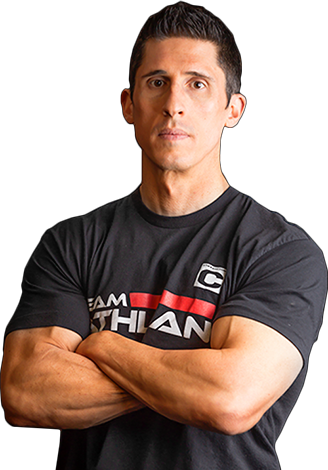
Jeff Cavaliere M.S.P.T, CSCS
Jeff Cavaliere is a Physical Therapist, Strength Coach and creator of the ATHLEAN-X Training Programs and ATHLEAN-Rx Supplements. He has a Masters in Physical Therapy (MSPT) and has worked as Head Physical Therapist for the New York Mets, as well as training many elite professional athletes in Major League Baseball, NFL, MMA and professional wrestling. His programs produce “next level” achievements in muscle size, strength and performance for professional athletes and anyone looking to build a muscular athletic physique.
